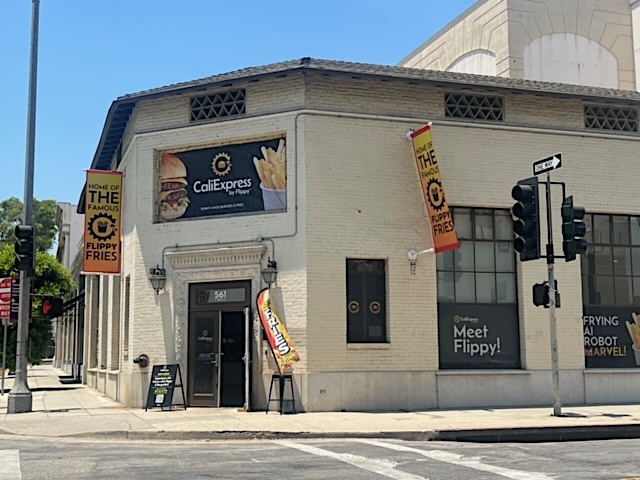CaliExpress by Flippy bills itself as the world’s first fully autonomous restaurant.
The fast-food restaurant, operated by Miso Robotics in Pasadena, California, is an hour’s drive from my home, so I set out after the July 4 holiday to check out the pop-up eatery.
At first glimpse, CaliExpress looks like any other modern fast-food restaurant with beverage coolers, kiosks, and booth seating.
Ann Rochanayon of Northern California thought the same thing.
Rochanayon, visiting the Los Angeles area with her family, had heard about the autonomous restaurant online. Curious about the technology, the family popped in for a visit.
“It looks normal,” she said as she looked around the restaurant.
Even the kiosks didn’t impress her as they’ve become ubiquitous in many fast-food restaurants, she said.
But, her first impression changed dramatically once she observed the exhibition kitchen in action. A brand ambassador for kiosk provider PopID, Denise Koons, explained how the burger bot grinds meat, and then places the formed burger onto a two-sided grill. From start to finish, the process takes 185 seconds.
“No, really?” Rochanayon said, her eyes widening with wonder.
As if they were paparazzi spotting a celebrity, Rochanayon and her husband immediately swarmed the counter to take video of the burger and fry robots in action.
Still, the restaurant is not fully autonomous. There’s at least one employee who works with the robots. That makes sense, as someone has to do the prep and assemble the food after it’s cooked.
If you’re looking to reduce labor, one person per shift is groundbreaking.
That’s why national brands such as McDonald’s, Jack in the Box, White Castle, and Sweeetgreen are testing robotics and automation in the kitchen. New York City startup Kernel, a plant-based concept by Chipotle founder Steve Ells, also uses back of the house robotics. For nearly three years, Nala Robotics has run a fully automated restaurant in Naperville, Illinois. They offer multiple robotic chefs, including a fry cook called Wingman.
CaliExpress by Flippy aims to showcase the possibilities of an all-robotics restaurant – an idea that is gaining traction among fast-food operators looking to find reliable and affordable labor.
Melissa Rosen, a business development representative for Miso Robotics, told Food on Demand that brands with over 200 units, as well as some emerging brands, have stopped by the pop-up restaurant to witness the robotics in action.
And seeing is often believing.
“Oh, now I get it,” observers have told Rosen.
Next month, brands will have even more to check out as Miso Robotics debuts an upgraded version of Flippy. The next-gen Flippy is smaller in size and twice as fast.
“We’re building a product that is truly scalable,” CEO Rich Hull told investors during a July 9 webinar discussion about the next-gen Flippy. “He’s a massive revenue opportunity for us.”
Here’s a closer look at CaliExpress by Flippy:
Kiosks by PopID
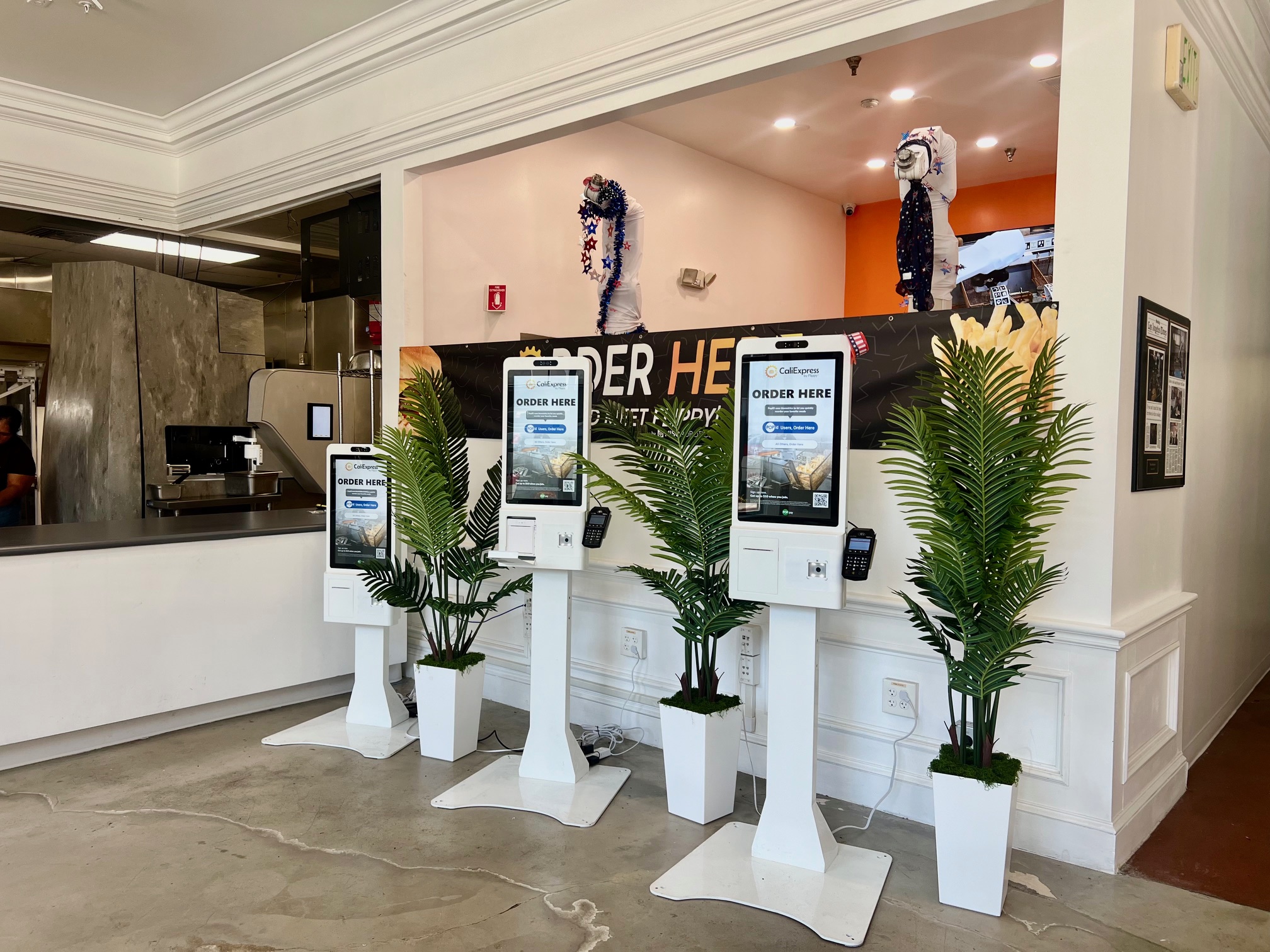
CaliExpress uses kiosks by PopID.
The restaurant features three kiosks powered by PopID, which uses biometrics to simplify ordering and payments. PopID is a part of the holding company Cali Group, which invests in disruptive and transformational retail and restaurant technologies. CaliGroup is a majority owner of PopID, and an investor in Miso Robotics, the maker of Flippy the fry cook.
Paying with your face
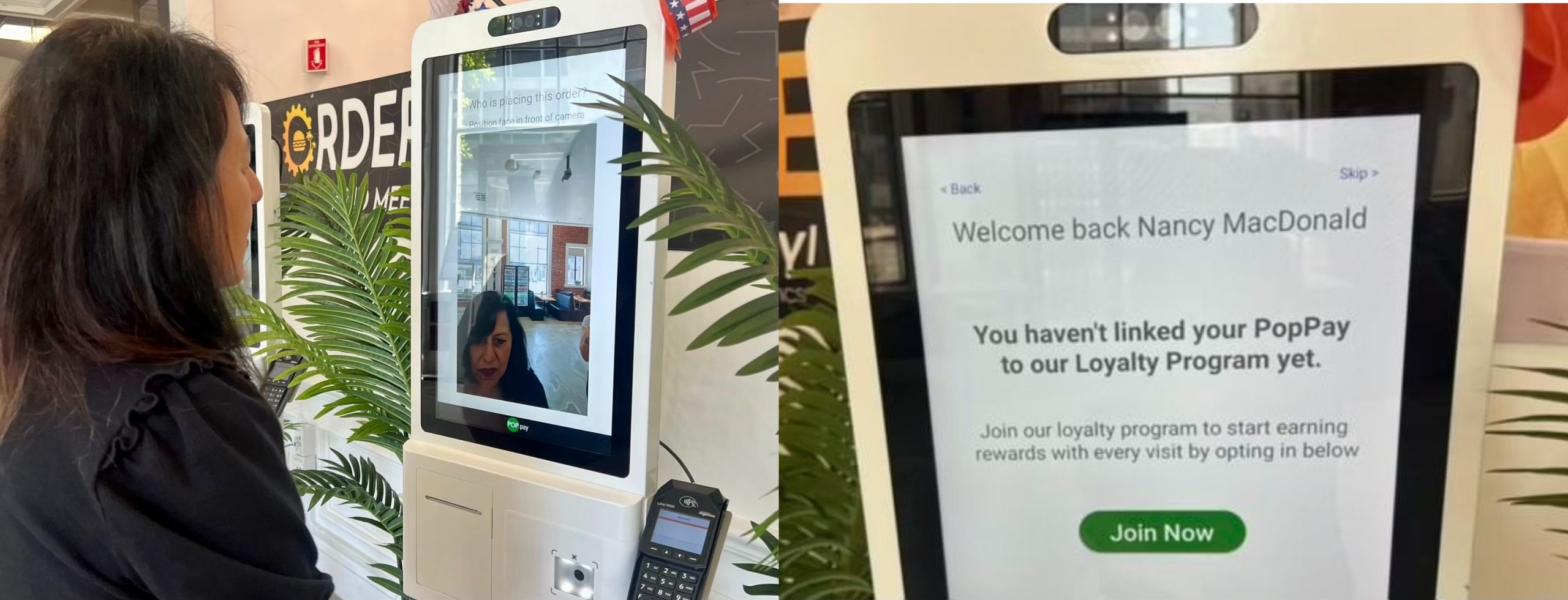
The kiosk scanned my face to retrieve my account.
The kiosks function like most self-serve, touchscreen ordering devices. Guests scroll to make food selections, then pay with a credit card. However, customers can choose to pay with their face.
A QR code on the kiosk allows you to create a PopID account that uses an image of your face to log-in similar to facial recognition software used on an iPhone.
“Your picture is translated into a secure digital key and stored in the PopID cloud,” the tech company states on their website.
I created an account in a few seconds using my phone. I had the option to store a credit card. Once registered, the PopID kiosk pulled up my name after it scanned my face. Once you store a credit card, customers don’t have to pull out a credit card as you pay with your face.
“You can forget your wallet, but you can’t forget your face,” Koons said of the convenience of PopID.
In April, Steak n Shake announced plans to install PopID in more than 300 U.S. locations, making it the first national chain to adopt biometric check-in and checkout nationwide, both companies said.
The menu
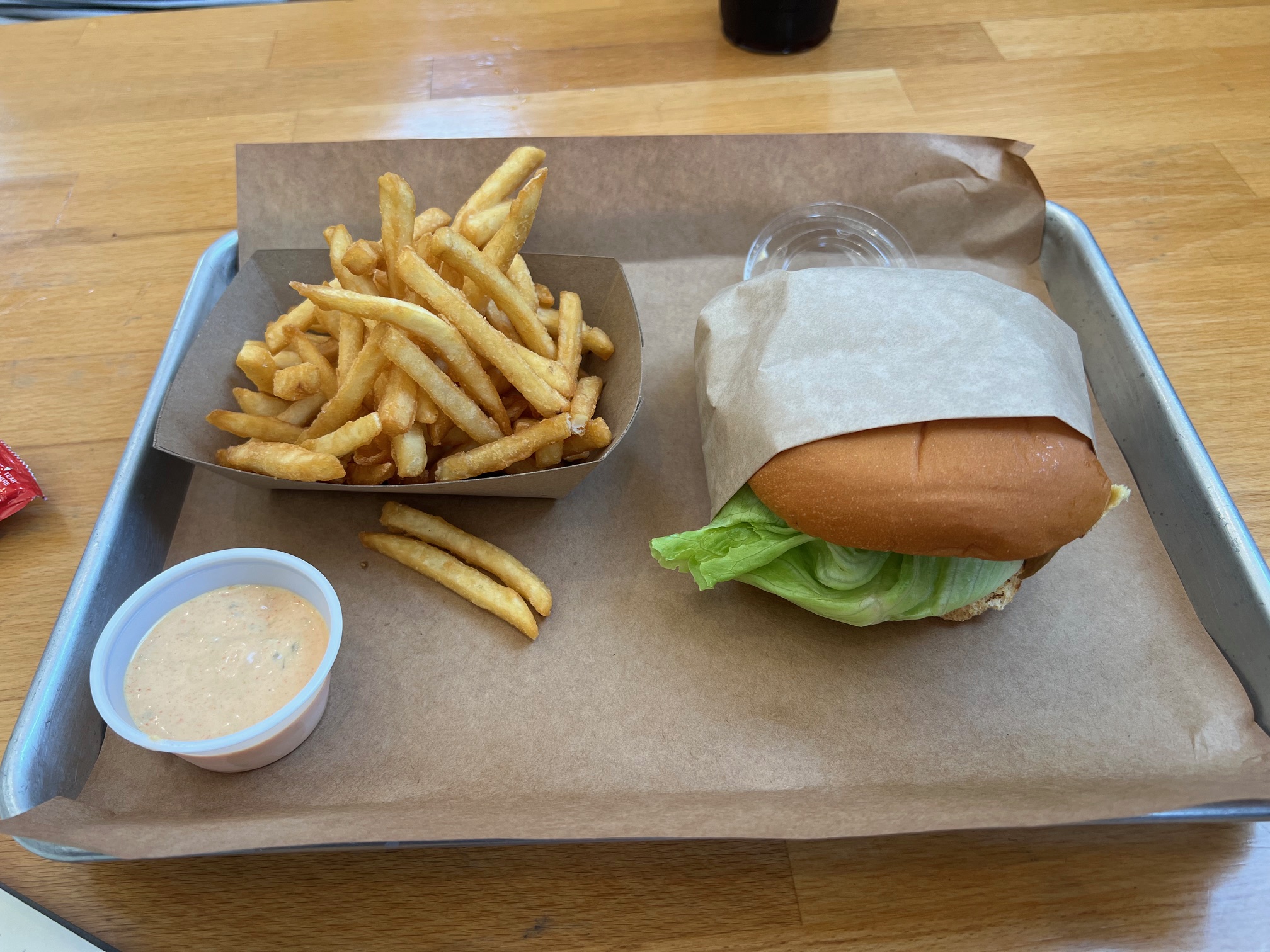
I ordered a burger, fries, Cali sauce, and a bottle of water.
Given that everything is cooked by robots, I expected the CaliExpress menu to be extremely limited.
But it actually has a lot of items to choose from including, a variety of wagyu burgers, a protein-style burger, a fried chicken sandwich, fried chicken tenders, a garden salad, fries, onion rings, and sweet potato waffle fries.
Soda drinks are limited to bottled Coca-Cola beverages.
Robots grill and fry the food
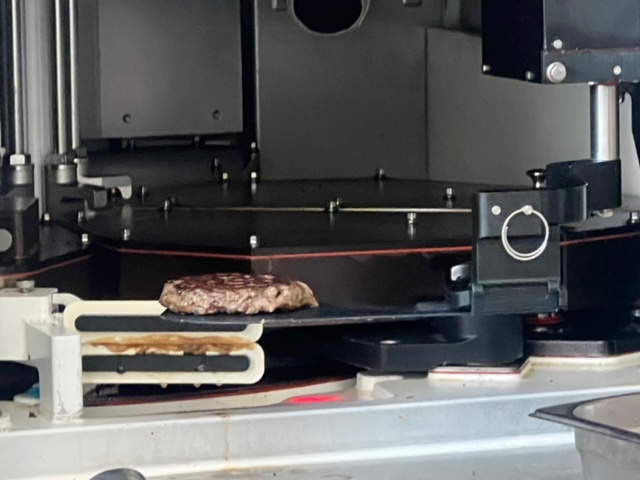
Burgers are cooked by a bot created by automation equipment company Cucina.
After ordering, most people would sit down and wait for their food.
But, if you do that, you’ll miss all the action.
The open kitchen features a burger bot by Cucina, a 15-month-old automation company based in San Francisco. Cucina’s burger bot grinds the meat to order and then places a formed patty onto a two sided grill. The grill smashes and cooks the patty.
From start to finish, the whole process takes about 185 seconds.
The bot can make about 100 patties an hour.
Flippy goes into action
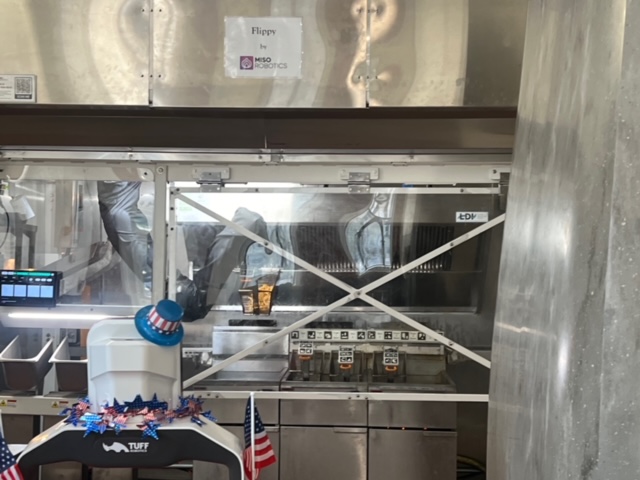
Miso Robotics is using CaliExpress to showcase Flippy.
In the back of the kitchen, Flippy is hard at work managing four fryers that cook fries, waffle fries, onion rings, and fried chicken.
Flippy, the star of CaliExpress, can fry about 250 pounds of fries in one hour. The AI-powered robotic arm moves along a rail system, handling multiple baskets simultaneously.
Rosen mentioned that interest in Flippy has surged over the past few months as many restaurant chains face labor shortages and high turnover rates for demanding back-of-the-house jobs like fry cooks.
Currently, select Jack in the Box and White Castle restaurants are testing Flippy, which made its first appearance in 2017 as a burger flipping robot.
Flippy didn’t last very long as a burger cook.
Alana Abbitt, Miso’s vice president and head of product development, told Food on Demand that Miso Robotics pivoted from burgers because chains were looking for automated solutions at fry stations.
“That station covers more menu items and therefore helps to free up more of employees’ time to do other tasks,” Abbitt said. “The fry station is also one of the hardest positions to fill. As we look to the future we see Flippy as the ringleader in the kitchen orchestrating our own products and working with 3rd party products, this can include burger makers in the future like we have at CaliExpress by Flippy.”
Flippy 3 is coming soon
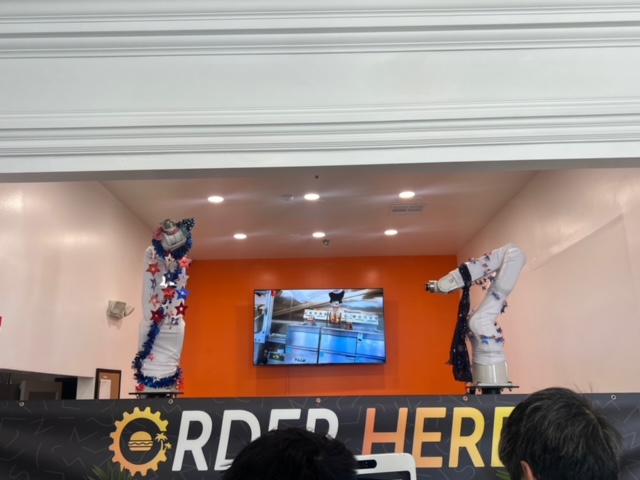
Miso Robotics plans to debut a faster and smaller Flippy next month.
A new version of Flippy is expected to roll out next month.
Bachir Kharraja, Miso’s chief technology officer, said during the webinar that one of the challenges of the current version of Flippy was its size. There’s not enough space in some quick-service kitchens to install the equipment as Flippy is “a little too big,” he said.
That’s why Miso is “shrinking the size of the unit,” he said.
Abbitt told Food on Demand that the changes are the most material improvements made to Flippy since the bot switched its focus to frying.
“It’s expected to be half the size, take half as long to install, and be twice as fast,” she said. “It will also provide a treasure trove of critical data to restaurant operators, and will feature massive improvements in Miso’s proprietary AI and machine learning, an innovative vision system, new hardware and software design, and a more intuitive user experience.”
Hull said during the webinar that Flippy can bring about $20,000 of positive monthly profit for restaurants.
To date, nearly 36,000 investors have invested more than $129 million in Miso Robotics.
Say hello to Tuffy
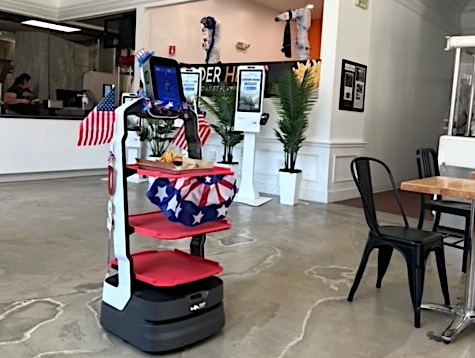
Tuffy, a robot food runner by Tuff Robotics delivers food to your table.
Robotics don’t stop at the back of the house at CaliExpress. The pop-up restaurant recently added a robot food runner called Tuffy.
If you’re a dine-in customer, Tuffy delivers food to your table.
Tuffy is a straightforward bot with good manners.
Equipped with three red trays for carrying food, Tuffy approached my table and said, “Welcome to CaliExpress by Flippy. My name is Tuffy. Please pick up your meal.”
After I grabbed my food, I sent Tuffy back to the kitchen by tapping a prompt on the touchscreen tablet. Before turning to leave, Tuffy said, “Please enjoy your meal. I am going back.”
Showcasing the future of food

Chippy the fry cook was another iteration of Flippy.
CaliExpress by Flippy also serves as an innovation showroom.
Visitors can explore the development of Flippy over the years. A 3-D printer, used to create robot parts promptly during the R&D phase, is also on display.
Chippy, the fry bot for tortilla chips that debuted in 2021, is showcased as well.
“Chippy is part of our innovation lab that is a sandbox where we test and learn from products. Several of the Chippy learnings are in our next generation of Flippy that is modular to allow for any number of fryers,” Abbitt said.
Chippy was briefly tested by Chipotle in Orange County, California. However, the chain told Food on Demand that the experiment is over.
“We tested ‘Chippy’ in one restaurant in Orange County, but it did not pass our stage gate process due to the setup and cleanup offsetting a lot of the labor savings,” company spokesperson Erin Wolford told Food on Demand.
Human prepared, robot cooked
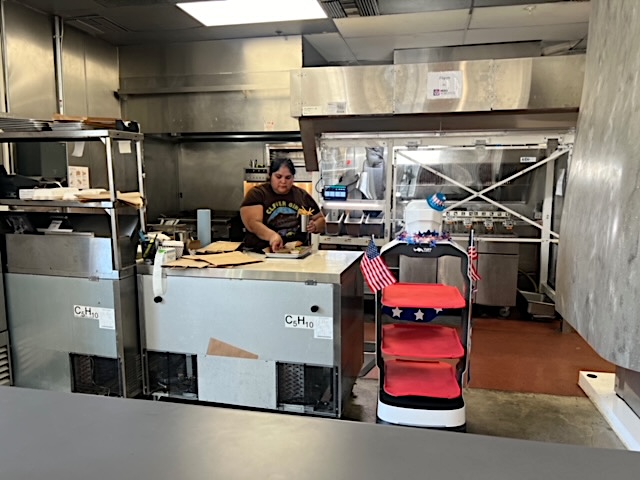
Geno Castro is a manager at CaliExpress who works with the robots.
CaliExpress, which opened in the spring, bills itself as the “world’s first fully autonomous restaurant.”
Well, that’s true for the cooking aspect of the operation.
However, the restaurant still needs employees to prep ingredients for the robots and assemble the final meals once the burger patties and fried foods are cooked.
That’s where Geno Castro comes in. The CaliExpress manager was the only employee working during my visit. Rosen said she’s one of three employees who work at the restaurant, which is open from 11 a.m. to 4 p.m. daily except Sundays.
Castro preps ingredients and helps troubleshoot any issues with the robots. She said Flippy makes her life easier.
“Working with the robots is my favorite part,” she said of her various job roles. “For the most part, they work on their own. The only thing that slows them down is me.”
Nancy Luna is a contributing writer for Food On Demand. She can be reached at [email protected]

